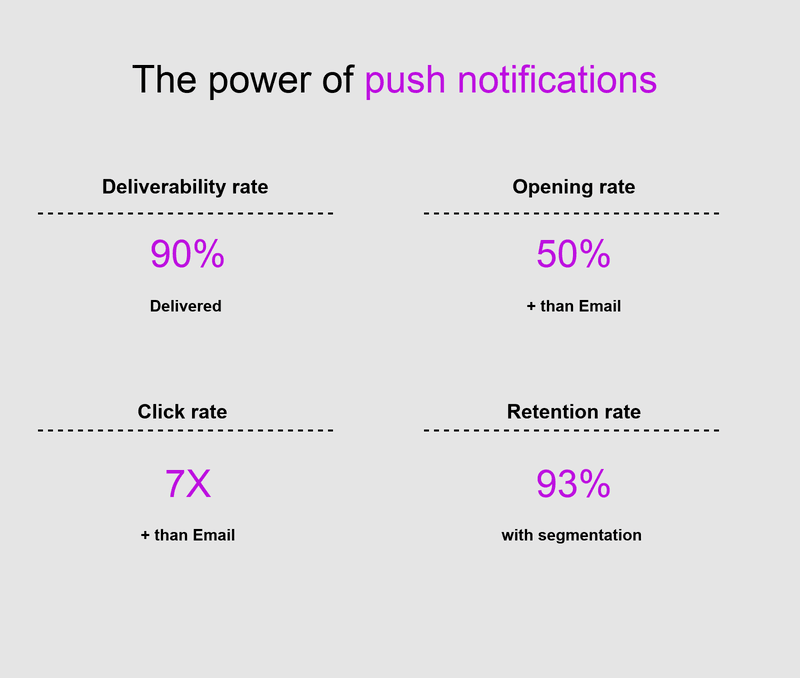What do your regular breakfast and successful marketing strategies have in common?
The best ones involve variety.
Give it a thought. As a blogger, to be successful with marketing, you must employ different methods, tactics, and test strategies to determine what works best for your business. You can’t just go all-in on one thing.
So what can you do to diversify your marketing strategy?
Simple, use Web Push Notifications.

Not only do push notifications let you communicate updates to your audience, they enable you to drive traffic to your website or landing page, build your audience, and grow your business. Plus, they work great in tandem with email marketing.
Web push notifications are notifications that can be delivered to a user through web browsers.
These are alert-style messages that slide in at the top or bottom right-hand corner of a desktop screen, depending on the operating system. It might also appear on a mobile device in a manner nearly identical to push notifications delivered from apps.
Web push notifications are delivered on a user’s desktop or mobile screen anytime they have their browser open. It doesn’t matter if the user is on your website or not.
Web push notifications are usually short and have the ability to evoke users' interest to make an action. Most importantly, it has almost twice the open rate and higher CTR than other major marketing channels like email.
An in-browser notification is another form of online messaging that targets active website visitors when they are actively on your website.
Mobile push notifications are the types of notifications that appear on a mobile device. These messages go to a user’s phone and show up on a lock screen.

When a user opens a push notification, it will bring the user to whatever app sent the message. Much like web push notifications, users can opt-in and opt-out of receiving notifications.
But in this article, we’ll be covering all you need to know about web push notifications.
They differ from in-browser notifications and mobile push notifications in that a user does not need to be on the website to receive the push notification. This allows marketers to reach users when they’re not actively engaging on a website.
Web push notifications are a must-have for each and every business that focuses on growth. In this article, we will dive into the topic of why should you care about web push notifications if you are any of these:
If you’re handling a publishing or blogging website, driving traffic to your website (both repeat and first-time) is likely the most important thing for you.
Because more traffic leads to more paid subscriptions. On top of that, more traffic leads to greater visibility for ads displayed on your website and, eventually, it allows you to command more revenue from advertising.
Web push notifications give publishers and bloggers the ability to drive traffic by nudging their readers to return to the website.
According to a study done by Oppolis Software, digital publications that use push notifications see an increase of 102% in overall downloads compared to publications that don’t use notifications.
One of the main advantages of web push notification is that it demands immediate action on the part of the subscriber. Either the subscriber closes the notification or he clicks on the notification and is taken to the content.
Publishers can use this unique functionality by sending instant content through push notifications. When it is sent in the form of a web push notification, this becomes a “digital nudge” encouraging the subscriber to know more and return to the website.
Studies show that email and social media are the most effective marketing channels. Email still provides the highest ROI of any single channel.
But not all first-time visitors are comfortable providing their email addresses. That’s where web push notifications come in - helping your users take the first step in building a relationship with your brand.
Combining your web push notifications and email creates a winning marketing strategy by giving you additional touchpoints to connect with your audience.

With Push notifications, subscribers will get your notifications at any time right at their browsers. You don’t need users browsing your websites to send it, offering you a better channel compared to email.
Another advantage of push notifications is, subscribers don’t need to log in to Google or Twitter, or Facebook to receive the notifications. They could be anywhere on the web to receive your notification.
Opting in to receive web push notifications is a one-click process. Compare this to the email opt-in process, which requires the reader to enter his email address at the very least.
This increases push notification opt-in compared to email. Opt-in rates for web push notifications can range from 6% to 12%. Some early studies have shown push notifications to have an opt-in rate 10x times the rate at which an average email list builds.
You can track clicks on messages in an email campaign, but you need to do it through an email marketing platform or some other third party.
In the case of web push notifications, you can just paste the integration code and start following subscriber behavior on your website right away. It gives you a more advanced capability of verifying their interests, predicting their future behavior, and better targeting of campaigns, thanks to personalization - all in real-time.
If the only reason you’re building an app is to send users instant notifications, then a better option would be to simply subscribe readers from your mobile/desktop website and send them web push notifications.
In fact, the debate between apps and websites is still ongoing. Some experts say that for small and medium-sized companies, mobile websites reach more people than apps do.
Another factor to be considered here is cost. Sometimes, building an app just doesn’t make sense from a financial and business standpoint.
Considering this, web push notifications are a great way to leverage the power of interactive, instant communications with your readers, without incurring the cost of building an app.
You can follow geo-location-based data, and choose the right time to send web push notifications. Nobody likes to get notifications early morning or in the middle of the night.
You can design your notifications strategy that is in line with the behavior of your target readers.
You shouldn’t send breaking news in the middle of the night. But you can send the same push updates during the “peak hour” or in the evening.
It doesn't matter if they are on smartphones or desktops, browser push notifications can reach them as long as they have an active internet connection.
This precise marketing channel allows your users full control over the subscription. They can opt-in anytime, and disable browser push notifications anytime they want.
Your audience has a thousand better things to do than read your lengthy emails. Push Notifications are crisp messages sent directly to their browsers.
The time to grasp information is reduced to just a few seconds for your end-users as web push notifications are limited in terms of character length.
So get rid of the jargon and the first paragraph you use for courtesies & introductions - come straight to the point.
A web push notification message takes less time to create than other marketing copy because they are short in length and concise.
You can use it to make your subscribers aware of limited-time offers the minute you launch. Don’t let them miss out on a great opportunity — they’ll appreciate the heads up.
When your potential subscribers agree to receive notifications, these are saved in their browser. Therefore, no ad blockers will affect the delivery of your messages.
Moreover, no cookies are needed!
To identify a subscriber, the browser uses unique keys for each account, including service workers, eliminating the need for cookies.
Probably the most crucial thing to consider while scaling up your push notification campaigns is the frequency of your messages.
Since push notifications are a high-engagement communication channel, you need to be really careful not to inundate your subscribers with more notifications than they can handle.
Furthermore, since website push notifications are a comparatively new channel, there is no data out there on optimal frequency.
You need to carefully monitor your click-through rates (CTR), time on page, bounce rate, and opt-outs after every push notification to find out which frequency works best for your audience.
Web push notifications are gaining popularity among bloggers and publishers all around the world. A strong web push notification strategy may significantly increase engagement and conversion rates on your website in a short period of time.
And with the right tool, you can create web push notification campaigns that can help you boost your revenue and reach your audience across various channels. That’s the reason why you should give Monsy a shot!
Monsy is specially built for bloggers and publishers to easily capture the audience and efficiently market to them across multiple platforms.
So what are you waiting for? Get your skates on, sign up today to grow your revenue up to 85%, and harness the power of web push notifications.